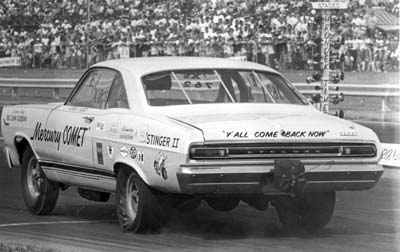|
Ironically, the winner of Super Eliminator was a Comet driver, but
not any of the above four (Chrisman's Comet burned in a top-end fire
after clocking an 8.63, 176,12 - top speed). Instead, Pete Gates, the
Friday and Saturday winner of the 2,700-pound fuel class with Nicholson's
'65 Comet, utilized handicaps to his advantage and won.
In the final, Gates beat Schartman with a 9.14 when Schartman got out
of shape and shut off at half track.
The 1966 race marked the last time that the Super Stock race used a
format with class winners and their elapsed times for an overall single
winner.
In 1967, the Super Stock Nationals event made its third site move in
as many years. Despite the success of the New York event, Super Stock
management decided to move the event to Cecil County Drag-O-Way in Bayview,
Md., a track that could be accurately described as the hot bed of "doorslammer"
action on the DelMarVa Peninsula (Delaware, Maryland, Virginia). This
race would also be the last of the handicap Super Stock races. Management
decided to run the same classes as they did at York and New York, with
an overall eliminator deciding the whole issue.

Tommy Grove's "Ford Charger" 2,400-lb. fuel injected Mustang was the
star of the weekend. He ran off Ken Vogt's 2,700-lb. Mercury Comet (photo)
in the final to win a race that had been astoundingly quick. Californian
racers Butch Leal and Jack Chrisman shared low e.t. with an 8.03 with
Grove healthily ensconced in the 8.40- and 8.50-second zone.
In the time between the 1967 and 1968 races, the Funny Car class as
a whole had undergone a metamorphosis of sorts. The blown and injected
nitro-burner was easily outrunning the injected nitro cars and it became
obvious that the blown cars deserved there own separate eliminator,
one that was not based on weight so much as what sat atop the engine.
In 1967, a few months after the Super Stock race, NHRA tried out their
first unlimited blown Funny Car eliminator at its U.S. Nationals and
the thing proved to be a big hit. Doug Thorley's Corvair ran as quick
as a 7.83 to win, but really stealing the headlines was Chrisman, who
qualified No.1 with a 7.60, a lap that was a quarter of a second quicker
than anything that had been run by a Funny Car. Thorley was No. 2 qualifier
with an 8.16 to give you an idea of the disparity.
This forced the hand of the Super Stock people and they began "headlining"
their races with the blown cars. This would prove to enhance the shows
as well as lead to their ultimate demise in terms of popularity. As
hardcore fans know, by the late 1960s Funny Cars began to surpass Top
Fuel dragsters in popularity. What this did was force the Super Stock
race to lead with Funny Car ... unfortunately, just like every other
track in the country, and this helped make the fabled magazine race
a little more anonymous.
|